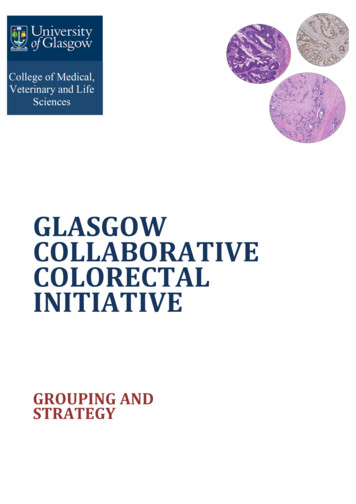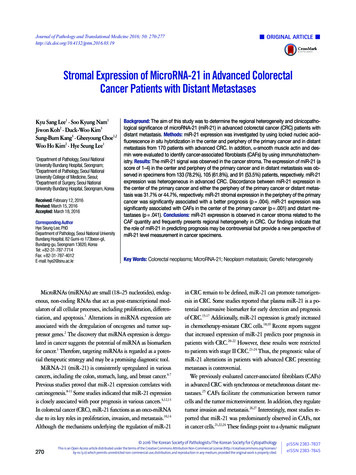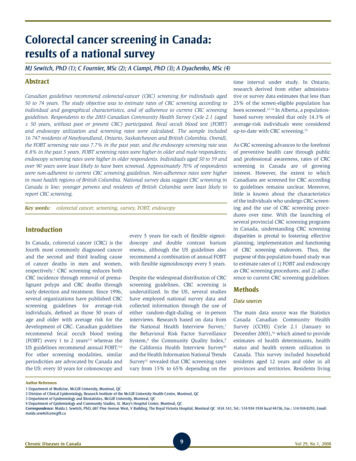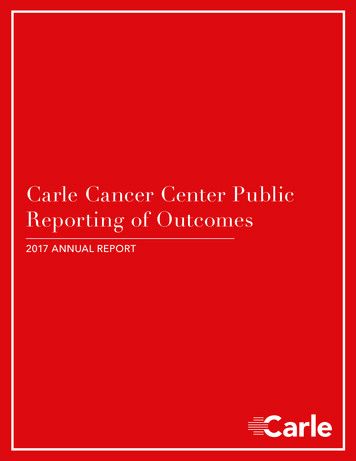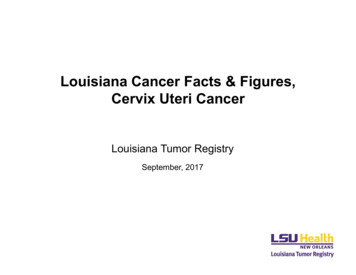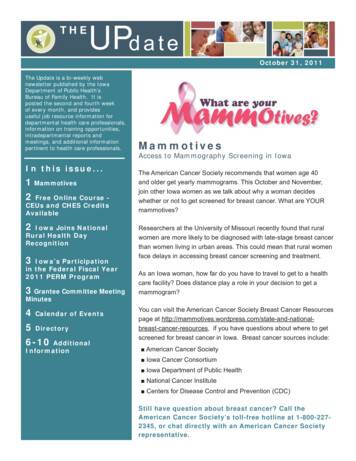
Transcription
Yan et al. Journal of Experimental & Clinical Cancer 2019) 38:353RESEARCHOpen AccessTubeimoside-I sensitizes colorectal cancercells to chemotherapy by inducing ROSmediated impaired autophagolysosomesaccumulationJianghong Yan1,2, Xiaoyun Dou1, Jing Zhou4, Yuanfeng Xiong2, Ling Mo2, Longhao Li3* and Yunlong Lei4*AbstractBackground: Tubeimoside-I (TBM), a plant-derived bioactive compound, shows antitumor activity in differenttumors and can enhance the efficacy of chemotherapeutic agents. However, the detail mechanism underlyingremains to be elucidated.Methods: The cytotoxic potential of TBM towards CRC cells was examined by CCK8 assay, colony formation, LDHrelease assay, flow cytometry method and Western blots. The ROS levels, autophagy, apoptosis, chemosensitivity to5-FU or DOX, etc. were determined between control and TBM-treated CRC cells.Results: In this study, we found that TBM could inhibit proliferation and induce apoptosis in colorectal cancer (CRC)cells. Intriguingly, TBM treatment could either promote autophagy initiation by ROS-induced AMPK activation, orblock autophagy flux through inhibiting lysosomal hydrolytic enzymes, which leaded to massive impairedautophagylysosomes accumulation. Administration of autophagy initiation inhibitor (3-MA or selective ablation ofautophagy related proteins) relieves TBM-induced CRC suppression, while combination use of autophagy fluxinhibitor chloroquine (CQ) slightly augments TBM-induced cell death, suggesting that impairedautophagylysosomes accumulation contributes to TBM-induced growth inhibition in CRC cells. Notably, as anautophagy flux inhibitor, TBM works synergistically with 5-fluorouracil (5-FU) or doxorubicin (DOX) in CRCsuppression.Conclusion: Together, our study provides new insights regarding the anti-tumor activity of TBM against CRC, andestablished potential applications of TBM for CRC combination therapies in clinic.Keywords: Tubeimoside-I, Autophagy, ROS, AMPK, ChemosensitivityBackgroundAlthough the dissemination of colonoscopy with polypectomy has led to a decline in the incidence and mortalityrates, colorectal cancer (CRC) still is the third most diagnosed cancers and the second leading causes of cancerdeath among both men and women worldwide, with over* Correspondence: llh@hospital.cqmu.edu.cn; ent of Oncology, The First Affiliated Hospital of Chongqing MedicalUniversity, Chongqing 400016, China4Department of Biochemistry and Molecular Biology and Molecular Medicineand Cancer Research Center, Chongqing Medical University, Chongqing400016, People’s Republic of ChinaFull list of author information is available at the end of the article1.8 million new colorectal cancer cases and 881,000 deathsin 2018 [1, 2]. If CRC patients can be diagnosed and treatedat localized stage, 5-year survival rate of which is about90%, that will decline to 71 and 14% for patients diagnosedwith regional and distant-stage disease [1, 3]. Adjuvantchemotherapy is the main treatment strategy for advancedCRC, however, a subset of patients eventually become relapsed because of acquired drug resistance to the currentcommonly used chemotherapeutic drugs and the effectiveness of chemotherapy has often been limited [4, 5]. Henceat present, development of new drugs for colorectal canceris an urgent need. The Author(s). 2019 Open Access This article is distributed under the terms of the Creative Commons Attribution 4.0International License (http://creativecommons.org/licenses/by/4.0/), which permits unrestricted use, distribution, andreproduction in any medium, provided you give appropriate credit to the original author(s) and the source, provide a link tothe Creative Commons license, and indicate if changes were made. The Creative Commons Public Domain Dedication o/1.0/) applies to the data made available in this article, unless otherwise stated.
Yan et al. Journal of Experimental & Clinical Cancer Research(2019) 38:353The stem tuber of Bolbostemma paniculatum (Maxim.)Franquet (Cucurbitaceae) is a traditional Chinese medicine named as Rhizoma Bolbostemmatis (Chinesename“Tu Bei Mu”) [6, 7]. It was listed in the Supplementto the Compendium of Materia Medica in Qing Dynastyfor treating breast cancer, acute mastitis, inflammationand snake venoms [6, 7]. Tubeimoside-I (TBM), a triterpenoid saponin, is isolated from Rhizoma Bolbostemmatisand shows antitumor activity in different tumor such aspromyelocytic leukemia, lung cancer, cervical cancer,nasopharyngeal carcinoma, esophageal carcinoma withlow toxicity [6, 7]. TBM could trigger a mitochondrial-related apoptotic pathway and cell cycle arrest in cervicalcarcinoma, ovarian cancer, choriocarcinoma and glioma[8–11]. TBM can also inhibit the growth and invasion ofCRC cells [12]. More interestingly, tubeimosides are effective in combination therapies, particularly at targetingdrug-resistant cancerous cells [13]. However, the underlying mechanisms of its anti-tumor activity have not beenfully clarified so far, especially in CRC.Autophagy is a highly conserved catabolic process during which de novo-formed membrane-enclosed vesiclesengulf damaged or senescent organelles and transport tolysosomes for degradation and recycling in response tonutrient starvation or metabolic stress [14, 15]. Autophagyplays an important role in the regulation of cancer progression and in determining the response of tumor cells tostress induced by chemotherapy [14, 15]. Four functionalforms of autophagy induced by chemotherapy have beendescribed to date: the cytoprotective autophagy which facilitates the resistance of cancer cells to chemotherapeuticdrugs, cytotoxic autophagy which promotes cell death, cytostatic autophagy which prolongs growth inhibition aswell as reduced clonogenic survival, and nonprotective autophagy which don’t affect drug or radiation sensitivity[16]. Considering the crucial roles during chemotherapy,targeting the autophagy process has recently attractedconsiderable attention to develop novel antitumor therapeutics via pharmacological modulation of autophagy.Tubeimoside-I can induce cytoprotective autophagy inhuman breast cancer cells in vitro, while promote cytotoxic autophagy in cervical cancer cells [17, 18]. However,the role of autophagy in TBM-treated CRC cells remainslargely unexplored, let alone the underlying mechanisms.In this study, we found that TBM inhibited the growthof CRC cells by stimulating apoptosis. Interestingly, TBMelicits autophagy by ROS-induced activation of AMPKand blocks autophagic flux by impairing the degradationof the autophagolysosome, which contributes to TBM-induced anti-cancer activity. Notably, as an autophagymodulator, TBM synergistically suppresses CRC cellgrowth with 5-FU or DOX. These findings provide the evidences for the use of TBM as a new therapeutic agentagainst CRC, especially in combination chemotherapy.Page 2 of 13Material and methodsCell cultureThe SW480 and SW620 cell lines were purchased from theAmerican Type Culture Collection (ATCC), HCT116and RKO cell lines were purchased from Shanghai cellbank. All cell lines were cultured according to theguidelines and were maintained in DMEM (Gibco) supplemented with 100 U/mL penicillin (Sigma), 10 mg/Lstreptomycin (Sigma), and 10% serum (Hyclone) in a humidified incubator at 37 C under 5% CO2 atmosphere.Reagents and antibodiesThe following primary antibodies were used: Lamp1 (SantaCruz Biotechnology), LC3 (MBL International Corporation),p62 (MBL International Corporation), PARP 1(Cell SignalingTechnology), PRKAA/AMPK (Cell Signaling Technology),phosphor-PRKAA/ AMPK(Cell Signaling Technology),Beclin1 (Cell Signaling Technology), ATG5 (Cell SignalingTechnology), CASP9 (Cell Signaling Technology), CASP3(Cell Signaling Technology) and Cleaved-CASP3 (CellSignaling Technology). TBM (BP1415) was purchased fromPhytopurify Biotechnology. 3-methyladenine (3-MA), chloroquine (CQ) and N-acetyl-L-cysteine (NAC) were purchasedfrom Sigma-Aldrich. Doxorubicin (DOX, HY-15142A) and5-fluorouracil (5-FU, HY-90006) were from MedChemExpress.TransfectionAll siRNAs were designed using BLOCK-iT RNAi Designer(Invitrogen) and synthesized by GenePharma (Shanghai,China). The sequences of the siRNAs used are listed inAdditional file 1: Table S1. Cells were transfected with siRNAs using Lipofectamine RNAiMax (Invitrogen) accordingto the manufacturer’s instruction.Dominant-negative AMPK (DN-PRKAA1/DN-AMPKα1)plasmid was obtained as described previously [19]. Theplasmids were transfected into the indicated cells usingLipofectamine 2000 (Invitrogen) according to the manufacturer’s instruction.ImmunofluorescenceCells grown on coverslips that treated with TBM for 24 hwere fixed with 4% paraformaldehyde (Sigma) for 30 minand then washed three times with PBS. Fixed cells werepermeabilized with 0.4% Triton 100 and 5% BSA for 1 h at37 C. For staining, cells were incubated with primary antibodies for 12 h at 4 C, followed by incubation with secondary antibodies (Thermos Fisher Scientific) for 1 h at37 C. Finally, Nuclei were stained with DAPI for 10 min.For autophagy flux studies, cells were transfected withGFP-RFP-LC3 for 24 h and then treated with TBM for another 24 h. Images were captured using a confocal microscopy (Carl Zess Micromaging).
Yan et al. Journal of Experimental & Clinical Cancer Research(2019) 38:353Cell viability and proliferation assaysAs described previously [20], CCK8 assay was performedto determine cell viability. Briefly, cells were seeded in96-well plates at a density of 5000 cells. After treatment,CCK8 (Dojindo, Kamimashiki-gun, Kumamoto, Japan;CK04) were added and incubated for 40 min. The absorbance value was then determined at 450 nm.The long-term effects of TBM on CRC cell proliferation were analyzed with a colony formation assay. Aftertreatment, 1500–2000 cells were seeded in six-wellplates and the medium was changed every 3 days. Aftertwo weeks, cells were fixed with 4% paraformaldehyde(Sigma) for 30 min and stained with Crystal Violet foranother 30 min, then the colonies were washed threetimes and taken photos.Immunoblot and immunoprecipitationCells were lysed with RIPA buffer (50 mM Tris base, 1.0mM EDTA, 150 mM NaCl, 0.1% SDS, 1% Triton X-100,1% sodium deoxycholate, 1 mM PMSF) supplementedwith protease inhibitor cocktail (Sigma) and then proteinlysates were centrifuged and boiled with loading buffer.For immunoprecipitation, Whole cell lysates were prepared in RIPA buffer (40 mM Tris-HCl, pH 7.5, 150 mMNaCl, 0.5% Nonidet P-40, cocktail, 5% glycerol, 10 mMNaF) and incubated with 1 μg of antibody overnight at4 C. Next day, Sepharose protein A/protein G beadswere added for 2 h. The immune-complexes were thencentrifuged and washed 3 times using RIPA buffer. Alllysates were quantified by the BCA Protein Assay(Thermo Fisher Scientific) and analysed by SDS–PAGE.Transmission electron microscopyTransmission electron microscopy assay was used tovisualize autophagic vesicles. After 24-h TBM treatment,SW480 and HCT116 cells were fixed in glutaraldehyde(Sigma) and ultrathin sections were prepared using asorvall MT5000 microtome. Then, the sections werestained by lead citrate and /or 1% uranyl acetate and visualized by Philips EM420 electron microscopy.Flow cytometryAs described previously [21], the indicated cells treatedwith TBM for 24 h were harvested and washed threetimes with PBS, then resuspended and incubated withPI-ANXA5 solution (KeyGEN Biotech). Apoptosis wasanalyzed with a FACSCalibur flow cytometer (BectonDickinson, San Jose, CA USA).Reactive oxygen species (ROS) measurementIntracellular ROS level was detected by staining cells with 2′,7′-dichlorofluorescein diacetate (DCFH-DA) (GENMED,GMS10016.2) according to the manufacturer’s instructions.The DCFH-DA signal was measured with a FACSCaliburPage 3 of 13flow cytometer or a Molecular Devices SPECTRAMAX M5fluorimeter (490 nm excitation and 530 nm emission).Data analysis and statisticsData were expressed as means s.d. All experimentswere performed at least three times. Statistical analysiswas performed with GraphPad Prism 6.0 software.Statistical differences between groups were determinedusing two-tailed Student’s t-test. Significance was designated as follows: *, P 0.05, **, P 0.01, ***, P 0.001.ResultsTBM inhibits proliferation and induces apoptosis in CRCcellTo validate whether TBM exhibited antitumor effectagainst CRC, CCK8 assay was performed to assess thecell viability in response to TBM treatment in different human CRC cell lines. As shown in Fig. 1a, TBMtreatment for 24 h markedly decreased the cell viability of various CRC cell lines (SW480, HCT116,SW620 and RKO) in a dose-dependent manner. Consistently, the proliferation of CRC cells was significantly inhibited under TBM treatment, as evidencedby reduced colony formation (Fig. 1b). To further verify its anti-CRC activity, lactate dehydrogenase (LDH)release assay was performed and the results showedthat TBM treatment exhibited marked cytotoxicity inSW480 and HCT116 cells (Fig. 1c). The initiation ofapoptosis is largely involved in the antitumor activityof chemotherapeutic drugs, thus TUNEL assay andAnnexin-V/PI double staining flow cytometry methodwere used to evaluate whether apoptosis is involvedin TBM-induced cytotoxicity in CRC. As shown asFig. 1d and Additional file 1 :Figure S1A, TBM couldinduce a prominent apoptotic effect in CRC cells witha dose-dependent manner. The pro-apoptotic effect ofTBM was further supported by increased levels ofcleaved PARP1, CASP9 and CASP3, the specific andsensitive markers of apoptosis, in TBM-treated cells(Fig. 1e and Additional file 1 :Figure S1B). Taken together, these results indicated that TBM exhibited asignificant antitumor effect in CRC cells.TBM activates autophagy in CRC cellAccumulated evidence has shown that autophagy wasusually activated by chemotherapeutic drugs andcontributed to antitumor effect [14, 15]. To testwhether autophagy is regulated by TBM in CRC cells,we first examined the processing of LC3-I to its PEconjugated LC3-II, which is one of the most widelyaccepted methods for monitoring autophagy [22]. Asindicated in Fig. 2a and b, TBM treatment promotedthe turnover of LC3-I to lipidated LC3-II in a doseand time-dependent manner in CRC cells. In line
Yan et al. Journal of Experimental & Clinical Cancer Research(2019) 38:353APage 4 of 13CBDEFig. 1 TBM inhibits proliferation and induces apoptosis in CRC cells. a. SW480, HCT116, SW620 and RKO cells were treated with the indicatedconcentration of TBM for 24 h and cell viability was determined by CCK8 kit. b. Cell proliferation rate was analyzed by clone formation assay.SW480, HCT116, SW620 and RKO cells were treated with the indicated concentration of TBM for 24 h, after treatment, cells were seeded into 6well plates for two weeks and colony numbers were quantified. c. Analysis of dehydrogenase (LDH) release in SW480 and HCT116 cells subjectedto indicated concentration of TBM. Cell lysates serve as positive control. d. SW480 and HCT116 cells treated with 10 μM TBM for 24 h were fixed,stained with Annexin V/PI, and then analyzed by flow cytometry. e. Immunoblot analysis of PARP1 in HCT116 and SW480 cells. Data are means s.d. and are representative of 3 independent experiments. *, P 0.05; **, P 0.01; ***, p 0.001with this, accumulation of GFP-LC3 puncta was dramatically increased in CRC cells treated with TBM byfluorescence images (Fig. 2c). Furthermore, transmissionelectron microscopy experiment also showed that the appearance of double-membraned autophagosomes wasfrequently observed in CRC cancer cells treated withTBM (Fig. 2d).Next, we examined the expression levels of Atg5 andBeclin 1, two autophagy-related proteins, which is correlated with the extent of autophagosome formation.
Yan et al. Journal of Experimental & Clinical Cancer Research(2019) 38:353Page 5 of 13ABCDFig. 2 TBM induces autophagy in CRC cells. a. Immunoblot analysis of LC3 and p62 expression in SW480 and HCT116 cells treated with indicatedconcentrations of TBM for 24 h. b. Time course analysis of LC3 and p62 expression in SW480 and HCT116 cells treated with TBM (10 μM) for 6, 12,24, 48 h by immunoblotting. c. SW480 and HCT116 cells were transfected with GFP-LC3 for 48 h, and then treated with 10 μM TBM for another24 h. GFP-LC3 puncta was shown and quantitated by immunofluorescence analysis. Scale bar, 10 μm. d. Autophagic vesicles were detected bytransmission electron microscope in SW480 and HCT116 cells treated as in (C). Scale bar, 2.5 or 1 μm. Data are means s.d. and arerepresentative of 3 independent experiments. *, P 0.05; **, P 0.01; ***, p 0.001Results showed that TBM induced the expression ofAtg5 and Beclin 1 in a dose-dependent manner in CRCcells (Fig. 3a-b). While silencing the expression of Beclin1 or Atg5 using siRNA partially blocked LC3 lipidationin TBM-treated cells (Fig. 3c-d). Coadministration of 3MA, a class III PI3K inhibitor, with TBM failed to
Yan et al. Journal of Experimental & Clinical Cancer Research(2019) 38:353ACBDEPage 6 of 13GFFig. 3 TBM induces autophagy initiation in CRC cells. a. Immunoblot analysis of Atg5 expression in SW480 and HCT116 cells treated withindicated concentrations of TBM for 24 h. b. Immunoblot analysis of Beclin 1 expression in HCT116 and SW480 cells treated with indicatedconcentrations of TBM for 24 h. c. Immunoblot analysis of LC3 and Atg5 expression in CRC cells transfected with siNC or siAtg5 for 24 h, followedby treatment with or without 10 μM TBM for another 24 h. d. Immunoblot analysis of LC3 and Beclin 1 expression in HCT116 and SW480 cellstransfected with siNC or siBeclin 1 for 24 h, followed by treatment with or without 10 μM TBM for another 24 h. e. SW480 and HCT116 cells weretreated with vehicle, TBM (10 μM), 3-MA (5 mM), or in combination for 24 h. Immunoblot analysis was used to detect the expression of LC3. f.SW480 and HCT116 cells were transfected with GFP-LC3 for 48 h, and then were treated as in (E). The LC3 puncta by immunofluorescenceanalysis was shown and quantitated. Scale bar, 10 μm. g. Co-immunoprecipitation analysis of the interaction between Beclin1 and Bcl-2 in SW480and HCT116 cells treated with or without 10 μM TBM for 24 h. ***, p 0.001induce autophagy (Fig. 3e-f). In addition, it has been reported that the diminished interaction of Beclin 1 withBcl-2 are key events in the initiation process of autophagy [22]. As shown in coimmunoprecipitation assay,TBM treatment decreased the binding of Beclin 1 withBcl-2 (Fig. 3g). Collectively, our data suggest that TBMinduce autophagy initiation and autophagosome accumulation in CRC cells.ROS/AMPK axis contributes to TBM-induced autophagyinitiationPrevious studies have shown that TBM promote cell deathmainly by triggering a mitochondrial-related apoptotic pathway [13], which may decrease the production of energy andthen activate AMPK signaling pathway to initiate autophagy[23]. To ascertain this hypothesis, we detected the phosphorylation status of AMPK to validate whether AMPK was involved in TBM-induced autophagy. As shown in Fig. 4a,TBM treatment resulted in activation of AMPK as evidencedby increased phosphorylation levels of AMPK in a dosedependent manner in TBM-treated cells. To determinewhether the activation of AMPK was involved in TBMinduced autophagy, we transfected a siRNA targetAMPK to inhibit AMPK expression or domain negativeAMPK (DNAMPK) to inhibit AMPK activation. Asshown in Fig. 4b-c, inhibition of AMPK prominentlyinhibited elevation of LC3 lipidation in TBM-treatedcells. Dysfunction of mitochondria-induced activationwas mainly involved in ROS generation, thus, we determined whether TBM could increase cellular ROS levels.
Yan et al. Journal of Experimental & Clinical Cancer Research(2019) 38:353APage 7 of 13DBECFFig. 4 TBM-induced autophagy is dependent on ROS/AMPK activation in CRC cells. a. SW480 and HCT116 cells were tre flux signified autophagosomes fuse withlysosomes for further degradation, thus dysfunction oflysosomes may play an important role in inhibition ofTBM-induced autophagy flux. We firstly detected theexpression of lysosome- associated membrane protein(LAMP) 1, a marker for mature lysosome. As shownin Fig. 5f, TBM significantly up-regulated of LAMP1in a dose dependent manner, indicating that TBMpromote lysosomal mature. We subsequently examined whether autophagosome-lysosome fusion was affected by TBM by assessing the colocalization of
Yan et al. Journal of Experimental & Clinical Cancer Research(2019) 38:353endogenous LC3 with LAMP1. However, our resultsalso showed that TBM treatment induced obviouscolocalization of LC3 with LAMP1, suggesting thefusion of autophagosome with lysosome (Fig. 5g).Finally, we compared the lysosomal hydrolyticenzymes after TBM treatment by examining the levelof ubiquitinated proteins. Interestingly, ubiquitinatedprotein conjugates was increased following TBMtreatment (Fig. 5h). These results suggested that TBMimpairs autophagy flux by inhibiting proteolytic activity of lysosome.ROS-induced impaired autophagolysosomesaccumulation contributes to TBM-induced cell deathImpaired autophagolysosomes accumulation is harmfulto cancer cells and may lead to cell death. To evaluatewhether autophagy was involved in the anti-CRC effectof TBM, we transfected CRC cells with Beclin1 or ATG5siRNA, followed by TBM treatment. Cell viability wasmeasured with CCK8 assay and the pro-apoptotic effectwas examined by Annexin V/PI staining measured withflow cytometry. These data demonstrated that reductionin ATG5 or Beclin1 levels rescued the cell viability andinhibited the cell apoptosis caused by TBM (Fig. 6a andAdditional file 1 :Figure S2A). Furthermore, similar results were obtained by using the autophagic inhibitors,3-MA (Fig. 6b and Additional file 1 :FigureS2B). However, combination use of TBM with CQ slightly exacerbated TBM-induced cell death (Fig. 6b and Additionalfile 1 :FigureS2B). Next, we also elucidated the role ofROS accumulation in TBM-induced growth suppression.As shown in Fig. 6c-d, combinatorial treatment of TBMwith ROS scavenger (NAC) inhibited TBM-inducedgrowth suppression. In addition, treatment of NAC alsoreduced the pro-apoptotic effect of TBM, as evidencedby flow cytometry and levels of cleaved PARP1 (Fig. 4eand Additional file 1 :FigureS2C). These data indicatedthat TBM-induced autophagolysosome accumulation byROS contributes to cell death in CRC cells.TBM enhances the chemotherapeutic response of CRCcells response to 5-FU and DOXPreviously studies have found that pharmacological modulation of autophagy can merit exploration as a therapeuticstrategy for cancer treatment and can increase sensitivityof cancer cells to other chemotherapeutic agents whichusually induces protective autophagy [14–16]. As a specific autophagy flux inhibitor, we wonder if TBM can alsoenhance the chemosensitivity of CRC cells to 5-FU orDOX. Firstly, we determine the antitumor effect of 5-FUand DOX to CRC cell lines with a variety of concentration. As shown as Fig. 7a-b, the cell growth of CRCcells can be inhibited by 5-FU and DOX, however the effect is not obvious as the concentration increased. ToPage 9 of 13obtain the best result of TBM in combination 5-FU andDOX, CRC cells were combinational treated of TBM with5-FU or DOX in different concentration. The result reveals that 2 μM 5-FU combined with 0.2 μM or 0.5 μMTBM exhibits cost-effective anticancer effect in SW480cells and HCT116 cells, respectively, while 0.2 μM DOXcombined with 1 μM TBM markedly decreased the cellviability in both SW480 cells and HCT116 cells. Consistently, significantly lower cell growth and clone formationare observed in the combination arm with this treatment(Fig. 7c-d). Together, these results indicated that TBM effectively sensitizes CRC cells to 5-FU and DOX treatment.DiscussionRecently, TBM has been found to have considerable potential to inhibit various types of cancer [13]. Multiplemechanisms of TBM have been uncovered recently, including the modulation of multiple enzyme activitiesand signaling pathways [13]. It is of great interest to reveal novel activities and mechanisms of TBM in cancertreatment. In the present study, we demonstrated thatTBM exhibited potent antitumor effect on CRC. TBMinhibited the growth of CRC via inhibition of cell proliferation and induction of apoptosis. Interestingly, wealso found that TBM was a potent autophagy modulator in CRC cells. TBM initiates autophagy by activatingROS-AMPK signaling and impairs autophagy fluxthrough inhibiting lysosomal proteolysis activity, leading to the rough accumulation of autophagolysosomesin CRC cells. Meanwhile, our findings indicated that accumulation of immature autophagolysosomes by TBMtriggered apoptotic cell death. Our results also providedthe support that low concentration of TBM synergizingwith 5-FU and DOX shows preferential cytotoxicitycompared with treatment alone.Autophagy is a tightly-regulated catabolic process forclearing damaged or long-lived proteins and organelles,and plays important roles in response to various stressesincluding cancer treatment [14–16]. The role of autophagy in response to chemotherapy is multifaceted [14–16].On one hand, autophagy usually play a supportive role tohamper the anti-cancer effectiveness and induce drug resistance by preserving the organelle function and eliminating cellular waste products [14–16]. On the other hand,autophagy also can be pro-death or inhibit proliferation tobenefit the anticancer outcome [14–16]. In this study, wefound that TBM could significantly induce autophagy initiation and promote the fusion of autophagosome withlysosome, while impairs the degradation ability of autophagolysosome, leading to the robust accumu
The DCFH-DA signal was measured with a FACSCalibur flow cytometer or a Molecular Devices SPECTRAMAX M5 fluorimeter (490nm excitation and 530nm emission). Data analysis and statistics Data were expressed as means s.d. All experiments were performed at least three times. Statistical analysis was performed with GraphPad Prism 6.0 software.
